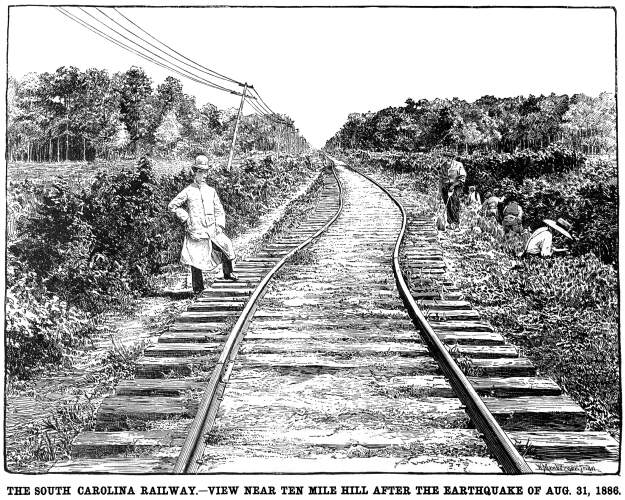|
Effect of the Earthquake on the
South Carolina Railroad
Scientific American—November 20,
1886
Never before in this country has there been, and if it is to
be hoped never again will there be, opportunity to present such
a picture of the effect of "the bottom dropping out of everything"
as that which we present in this issue in our engraving (an exact
reproduction of a photograph) of what was left of what had before
been a tangent on the South Carolina Railway, near the point where
a bad accident and worse scare occurred on the night of the earthquake
of August 31, and where (we presume) the dislocation was exceptionally
severe. It hardly seems possible that the sharp curve in the foreground
can be wholly due to a permanent dislocation of the surface, but
we are informed that it was, as also the quick drop in grade in
the "middle distance." The photograph gives obscure
evidence of still further dislocations in the background, which
has been rather softened than obscured in the engraving.
The Charleston & Savannah road is said to have suffered
on the whole even more severely than the South Carolina or the
Northeastern as respects dislocation, although all the serious
wrecks occurred on the other lines. Accounts of three of those
wrecks, including the one near the point illustrated, were given
in our issue of September 10, as also a description of the accompanying
" quakes." In connection with this engraving, the nature
of the catastrophe, and the fact that the description is probably
not exaggerated, can be better appreciated, and we therefore reproduce
the substance of it:
"Near Ten Mile Hill a fatal accident occurred on Tuesday
night. The down Columbia train (South Carolina Railroad) jumped
the track under the unseen influence of the shock that dismantled
the road. It is said that the earth suddenly gave way, and that
the engine first plunged down the temporary declivity. It was
then raised on the top of the succeeding terrestrial undulation,
and, having reached the top of the wave, a sudden swerving of
the force to the right and left hurled the ill-fated train down
the embankment.
"How it was done was plainly indicated. In many places
along the track of the South Carolina and the Northeastern railroads;
and for spaces of several hundred yards in width, the dreadful
energy of the earthquake was expended in two particular ways.
First, there were intervals of a hundred yards and more in which
the track had the appearance of having been alternately raised
 and depressed,
like a line of waves frozen in their last position. The second
indication was where the force had oscillated from east to west,
bending the rails in reverse curves, most of them taking the shape
of a single, and others a double letter S placed longitudinally.
These latter accidents occurred almost invariably at trestles
and culverts. There were no less than five of them between the
Seven Mile Junction and Jedburg. In other places the track had
the appearance of being kinked for miles, but always in these
cases in the direction of the rails. and depressed,
like a line of waves frozen in their last position. The second
indication was where the force had oscillated from east to west,
bending the rails in reverse curves, most of them taking the shape
of a single, and others a double letter S placed longitudinally.
These latter accidents occurred almost invariably at trestles
and culverts. There were no less than five of them between the
Seven Mile Junction and Jedburg. In other places the track had
the appearance of being kinked for miles, but always in these
cases in the direction of the rails.
"The train at the time of the earthquake was running along
at the usual speed, and when about a mile south of Jedburg it
encountered a terrible experience. It was freighted with hundreds
of pleasure seekers returning from the mountains. They were all
gay and happy, laughing and talking, when all of a sudden, in
the language of one of them, the train appeared to have left the
track, and was going up, up, up into the air. This was the rising
wave. Suddenly it descended, and as it rapidly fell it was flung
first violently over at the east, the side of the car apparently
leaning over at less than an angle of 45 degrees. Then there was
a reflex action, and the train righted and was hurled, with a
roar as of a charge of artillery, over to the west, and finally
subsided on the track and took a plunge downward—evidently
the descending wave. The engineer put down the brakes tight, but
so great was the original and added momentum that the train kept
right ahead. It is said on trustworthy authority that the train
actually galloped along the track, the front and rear trucks of
the coaches rising and falling alternately. The utmost confusion
prevailed, women and children shrieked with dismay, and the bravest
hearts quailed in momentary expectation of a more terrible catastrophe.
The train was then taken back in the direction of Jedburg; and
on the way back the work of the earthquake was terribly plain.
The train had actually passed over one of those serpentine curves
already described."
Two other accidents of the same general nature were likewise
described in the same issue. The only pleasant feature in these
occurrences, to a railroad man, is that at least it can be said
of them, with literal and indisputable truth, that "no one
was to blame." —Railroad Gazette.
Mother
Nature | Contents Page
|







